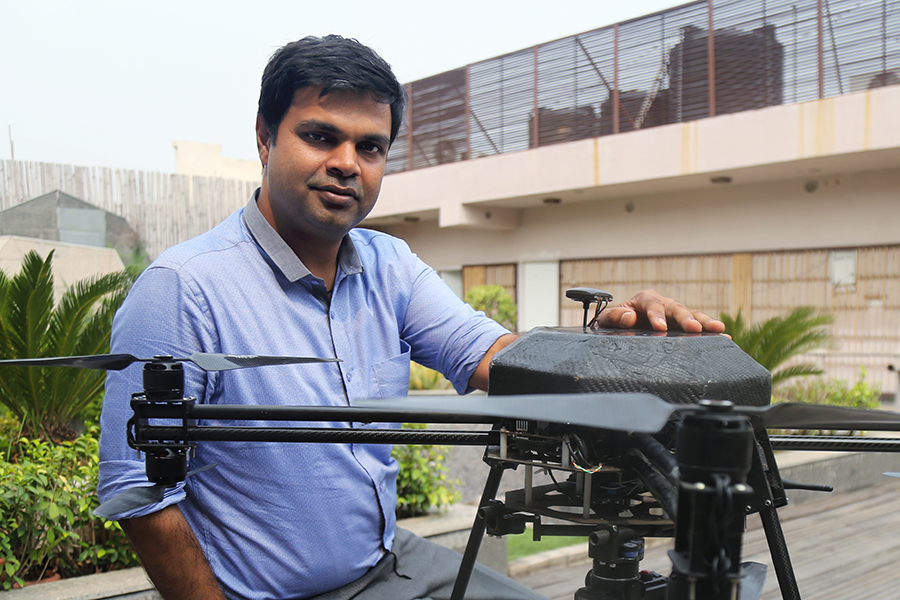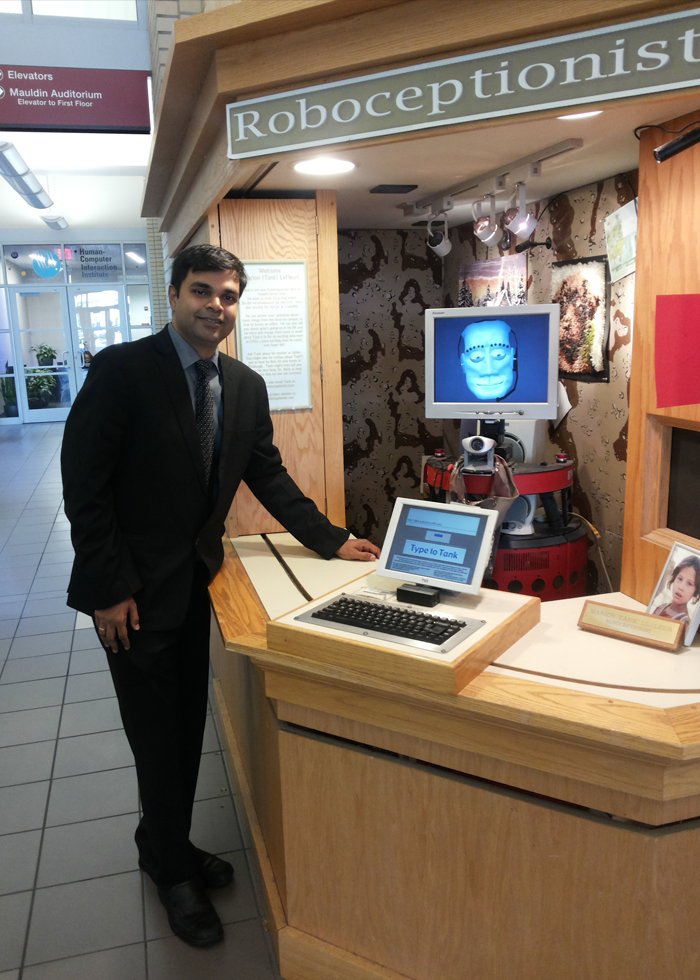
Future Flight
CMU alumnus is using robotics to address global problems — one drone at a time
By Amanda Hartle
Imagine flying a small, robotic aircraft from goal post to goal post on an American football field.
Now, repeat the flight 470 more times, and you’ll match the record-setting 32-mile, autonomous drone flight recorded by Aakash Sinha’s industry leading startup based in New Delhi, India.
"It's only the beginning,” says Aakash, a 2003 School of Computer Science graduate with a master’s degree in robotics. “I’m super excited about how drones can change things not just here in India but globally.”
From delivering vaccines in hard-to-reach areas to fighting hunger through increased crop yields to limiting fossil fuel leaks in expansive pipelines, the possibilities for positive change are endless.
“We are creating true value, not just valuation for investors,” says Aakash, who founded Omnipresent Robot Tech in 2009 and serves as CEO.
“We are creating products that have an impact on society.”
Disruption for Good
As Aakash and Omipresent Robot Tech see it, there are five sectors primed for drone disruption: e-commerce delivery, agriculture, defense, medicine and emergency.
Using computer vision, machine learning and virtual reality to secure visual analytics that inform actionable insights, the company is focused on the future of these areas.
“Eventually, you’ll see robots and drones work together in these domains, a robot on the ground and an aerial partner above,” Aakash says.
In a partnership with B Medical Systems, the company is in the midst of launching the first blood delivery service in India, which they hope to scale across the nation using more than 50,000 drones.
“In India, and many other countries, there are lots of deaths that happen because people don’t get blood in time,” Aakash says. “Maybe it’s a road accident or a maternal delivery, especially in a village without a lot of medical infrastructure. You suddenly require a certain type of blood, and you can’t get it.”
The service would station a drone in every regional center’s blood bank and cover a 30-kilometer radius, roughly 2,500 square kilometers in area.
“It will deliver the blood of required type within 30 minutes,” Aakash says. “It will cut out all the traffic and terrain that is mountainous or impassable, and it will save lives.”
The same efforts could be utilized for immunization efforts, and these “flying platforms” also could improve health outcomes through combatting crop diseases before they’re visible to the human eye.
With multispectral and hyperspectral sensors and specialized software onboard, the company’s Drone Agri Nerve Center platform can assess the amount of water and nutrient content in a plant and determine whether or not, these numbers are in the normal range or if they’re already infected.
“By the time plants show any visual markers, they’re beyond repair,” Aakash says. “But if you can detect them early enough with this kind of diagnosis, you can still save them with precision spraying, and that’s where this technology becomes very useful. It’s a clear case of boosting crop yield.”
Early detection of potential issues also can be applied to improve myriad industries like telecommunications and the estimated 5 million — and counting — cell phone towers around the globe. With drones, maintenance checks become safer and more accurate: relieving a human from climbing a tower, evaluating antennas and other components, ensuring everything is working properly and relaying correct data.
“Tower numbers are only going to grow with 5G coming and with a greater focus on improved deliveries with less environmental impact and more efficiency,” Aakash says. “Imagine getting pizza delivered from 50 miles away with no traffic, or a new iPhone within an hour without sending an entire truck for one item.”
“I’m fascinated whenever we're trying to build a robot. How do we make a robot more humanlike? How do we enhance some human capability using a machine?”
A Robotic Draw
Before coming to CMU, Aakash’s exposure to robots was mostly through movies.
“I realized there was so much more than that,” Aakash says. “I’m fascinated whenever we're trying to build a robot. How do we make a robot more humanlike? How do we enhance some human capability using a machine?”
And lucky for him, he crossed paths with a life-changing mentor during his undergraduate studies in electrical engineering at Dehli College of Engineering – Raj Reddy, Moza Bint Nasser University Professor of computer science and robotics in the School of Computer Science and founding director of the Robotics Institute at Carnegie Mellon.
Aakash told the robotics, AI and human-computer interaction pioneer about his interest in building robots, and Reddy connected him with a summer internship project at CMU.
“I was so fascinated that I wouldn’t even return home,” Aakash says of those first months on campus. “I just spent several nights at a stretch in the lab. I’d get up in the morning, go to the swimming pool, take bath over there, buy a half-gallon of chocolate milk and head back to the lab.”
He impressed Reddy during the internship and started his master’s program in 2002. More than 20 years later, Aakash talks regularly to Reddy, who heads up Omnipresent’s advisory board and is one of the company’s angel investors.
"I value my decades-long friendship with Aakash, and our work together through Omnipresent’s advisory board has allowed us to continue that relationship,” Reddy said.
And even after founding his own company — which also provided software and tech support to help India’s Chandrayaan II and III rovers navigate the Moon’s landscape — and engineering roles at iRobot and Lockheed Martin, he says he’s still never worked harder than his days at CMU.
“My advisor told me ‘Unless you make a true addition to the knowledge of humanity, you’re not getting your degree,’” Aakash laughs. “So I worked hard to make sure that I was solving a problem in an atmosphere that really supported my efforts.”
“The kind of people you meet everywhere on campus — students, faculty, everyone — just has this energy. There’s so much opportunity to grow in that energy.”
He expanded his focus beyond robotics and took advantage of CMU’s “fuzzy intradepartmental boundaries” by auditing classes in the arts and with late professor Randy Pausch in the Entertainment Technology Center.
“CMU opens up your mind in so many ways,” Aakash says. “You pick out problems that are worth solving, put in a lot of hard work. Even if they seem impossible, you can find a way out. Those are the things that I still carry with me.”
